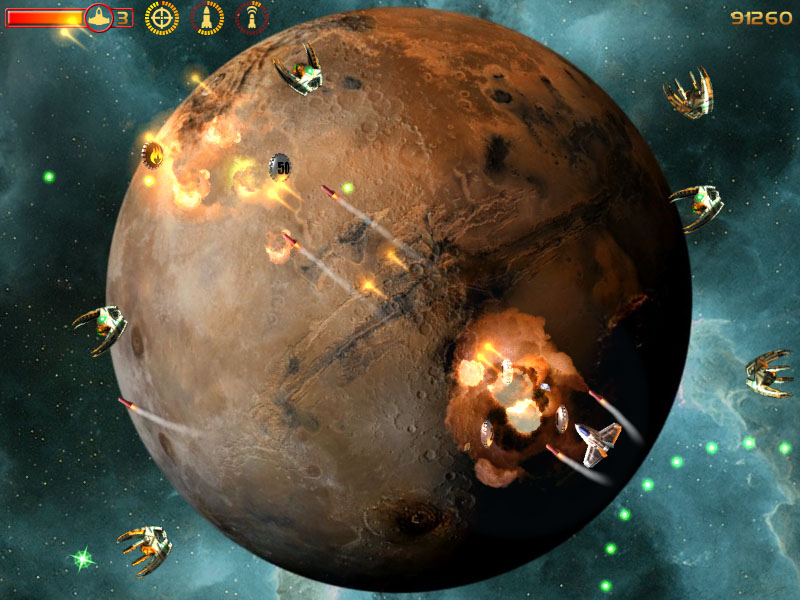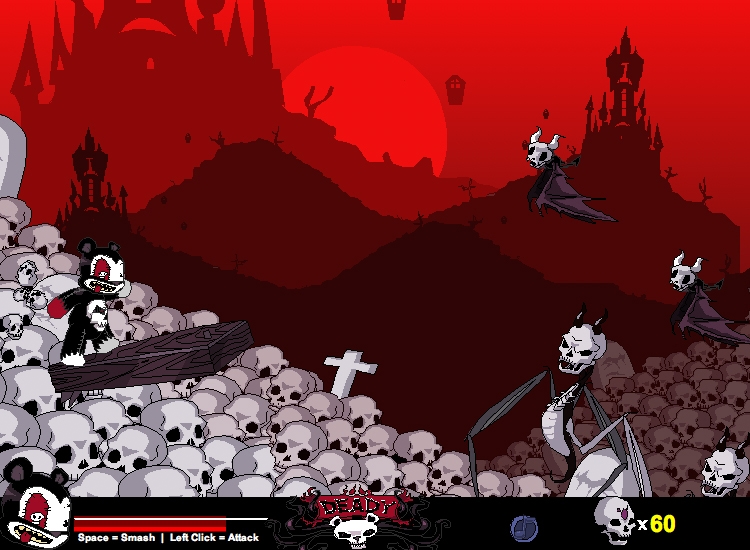Infobox VG
title=Asteroids
caption=
developer=Atari Inc.
publisher=Atari Inc.
distributor=
designer=Lyle Rains and Ed Logg
released=start date|1979
genre=Multi-directional shooter
modes=Up to 2 players, alternating turns
platforms=Arcade
input=Five buttons
cabinet=Upright and cocktail
arcade system=
cpu=
sound=
display=
Astrogeddon PC Game Free Download, Astrogeddon Portable PC Game Download Astrogeddon Mini PC Game Free Download, Astrogeddon Low Memory PC Game Free Download, Astrogeddon Direct Download Full PC Game Download.
'Asteroids' is a video arcade game released in 1979 by Atari Inc. It was one of the most popular and influential games of the Golden Age of Arcade Games. 'Asteroids' uses vector graphics and a two-dimensional view that wraps around in both screen axes. The player controls a spaceship in an asteroid field which is periodically traversed by flying saucers. The object of the game is to shoot and destroy asteroids and saucers while not colliding with either, or being hit by the saucers' counter-fire.
- Download free apps and files about Arcade such as: Monster Hunter Demo (linux), eLOADSTAR Sampler v1.0, Pacus Demo, Astrogeddon Client, Ad Gladium - Release Client v1.0, Wizard Of Wor - Hard Driving Demo, Bionicle Heroes Trailer, Sly 2: Band of Thieves GameSpy Movie.
- Astrogeddon is a high-speed, asteroid-blasting arcade game which fuses old-school gameplay with new-school cool. The game features fully rendered 3D graphics, 360-degrees freedom of movement, huge explosions and more than 20 types of enemy spacecraft, spread over a massive 100 levels.
Description

The game was conceived by Lyle Rains and programmed and designed by Ed Logg.[ [http://www.arcade-history.com/?n=asteroids&page=detail&id=126 asteroids, video game at arcade-history ] ] [Allgame [http://www.allgame.com/cg/agg.dll?p=agg&sql=4:2264 article] ] 'Asteroids' was a hit in the United States and became Atari's best selling game of all time.][ Atari had been in the process of releasing another vector game, 'Lunar Lander', but demand for 'Asteroids' was so high they stopped further production of 'Lunar Lander' so they could begin building 'Asteroids'Fact|date=June 2007. The first 200 'Asteroids' machines were sent out in 'Lunar Lander' cabinets. 'Asteroids' was so popular that video arcade owners sometimes had to install larger boxes to hold the amount of quarters that were spent by players.]
Astrageldon Slime
'Asteroids' is also the first game to use Atari's 'QuadraScan' vector-refresh system.[Asteroids Flyer, 1979, Atari, Inc] A full-color version known as 'Color-QuadraScan' was later developed for games such as 'Space Duel' and 'Tempest'.]
Gameplay
The objective of 'Asteroids' is to score as many points as possible by destroying asteroids and flying saucers. The player controls a ship that can rotate left and right, fire shots straight forward, and thrust forward. As the ship moves, momentum is not conserved — the ship eventually comes to a stop again when not thrusting. The player can also send their ship into hyperspace, causing it to disappear and reappear in a random location on the screen (with the risk of self-destructing or appearing on top of an asteroid).

Each stage starts with a few asteroids drifting in random directions on the screen. Objects wrap around screen edges — for instance, an asteroid that drifts off the top edge of the screen reappears at the bottom and continues moving in the same direction. As the player shoots asteroids, they break into smaller asteroids that frequently move faster and are more difficult to hit. Smaller asteroids also score higher points. Periodically, a flying saucer appears on one side of the screen and moves across to the other before disappearing again. The saucers are of two kinds: Large saucers fire in random directions, while small saucers aim at the player's ship.
The minimalist soundtrack features a memorable deep-toned electronic 'heartbeat', which quickens as the asteroid density is reduced by the player's fire.
Once the screen has been cleared of all asteroids and flying saucers, a new set of large asteroids appears. The number of asteroids increases each round up to a maximum of twelve. The game is over when the player has lost all of his/her lives.
Like many games of its time, 'Asteroids' contains several bugs that were mostly the result of the original programmers underestimating the game's popularity or the skill of its players. The maximum possible score in this game is 99,990 points, after which it 'rolls over' back to zero. Also, an oversight in the small saucer's programming gave rise to a popular strategy known as 'lurking' — because the saucer could only shoot directly at the player's position on the screen, the player could 'hide' at the opposite end of the screen and shoot across the screen boundary, while remaining relatively safe. This led to experienced players being able to play indefinitely on a single credit. [ [http://www.gamearchive.com/General/Articles/ClassicNews/1981/Esquire2-81-pg62.htm GameArchive article on 'Lurking' strategy] ] This oversight was addressed in the game's sequel, 'Asteroids Deluxe', and led to significant changes in the way game developers designed and tested their games in the future.Fact|date=July 2007

On some early versions of the game, it was also possible to hide the ship in the score area indefinitely without being hit by asteroids.
Technical description
The 'Asteroids' arcade machine is a vector game. This means that the game graphics are composed entirely of lines which are drawn on a vector monitor. The hardware consists primarily of a standard MOS 6502CPU, which executes the game program, and the Digital Vector Generator (DVG), vector processing circuitry developed by Atari themselves. As the 6502 by itself was too slow to control both the game play and the vector hardware at the same time, the latter task was delegated to the DVG.
Astrageldon Slime Calamity
The original design concepts of the DVG came out of Atari's off-campus research lab in Grass Valley, CA, in 1978. The prototype was given to engineer Howard Delman, who refined it, produced it, and then added additional features for Atari's first vector game, 'Lunar Lander'. When it was decided that 'Asteroids' would be a vector game as well, Delman modified a 'Lunar Lander' circuit board for Ed Logg. More memory was added, as was the circuitry for the many sounds in the game. That original 'Asteroids' prototype board still exists, and is currently in Delman's personal collection.
For each picture frame, the 6502 writes graphics commands for the DVG into a defined area of RAM (the vector RAM), and then asks the DVG to draw the corresponding vector image on the screen. The DVG reads the commands and generates appropriate signals for the vector monitor. There are DVG commands for positioning the cathode ray, for drawing a line to a specified destination, calling a subroutine with further commands, and so on.
'Asteroids' also features various sound effects, each of which is implemented by its own circuitry. There are seven distinct audio circuits, designed by Howard Delman. The CPU activates these audio circuits (and other hardware components) by writing to special memory addresses (memory mapped ports). The inputs from the player's controls (buttons) are also mapped into the CPU address space
The main 'Asteroids' game program uses only 6 KB of ROM code. Another 2 KB of vector ROM contains the descriptions of the main graphical elements (rocks, saucer, player's ship, explosion pictures, letters, and digits) in the form of DVG commands.
Legacy
Due to its success, 'Asteroids' was followed by three sequels:
* 'Asteroids Deluxe' (1980)
* 'Space Duel' (1982)
* 'Blasteroids' (1987)
The Killer List of Videogames (KLOV) credits this game as one of the 'Top 100 Videogames.' Readers of the KLOV credit it as the seventh most popular game.Fact|date=December 2007
The gameplay in 'Asteroids' was imitated by many games that followed. For example, one of the objects of 'Sinistar' is to shoot asteroids in order to get them to release resources which the player needs to collect.
Astrogeddon
Ports
'Asteroids' has been ported to multiple systems, including many of Atari's systems (Atari 2600, 7800, Atari Lynx) and many others. The 2600 port was the first game to utilize a bank-switched cartridge, doubling available ROM space. A port was in development for the 5200 and advertised as a launch title but never officially released, although an unofficial release was produced by AtariAge. 1993 saw a release for PCs with Windows 3.1 as part of the original 'Microsoft Arcade' package. Also, a new version of 'Asteroids' was developed for PlayStation, Nintendo 64, Windows, and the Game Boy Color in the late 1990s. A port was also included on Atari's Cosmos system, but the system never saw release. Many of the recent TV Games series of old Atari games have included either the 2600 or arcade versions of 'Asteroids'. Atari has also used the game for its other late '90s and 2000's anthology series. Essentially, if one looks for this game, one will be able to find it somewhere.
In 2004, 'Asteroids' (Including both the Atari 2600 port and the arcade original, along with 'Asteroids Deluxe') were included as part of 'Atari Anthology' for both Xbox and Playstation 2, using Digital Eclipse's emulation technology. (This package was released for the PC a year earlier under the title 'Atari: 80 Classic Games in One'.)
'Asteroids' was released via Xbox Live Arcade for the Xbox 360 on November 28, 2007, with an option for special revamped HD graphics and a high-speed 'throttle monkey' mode. [ [http://gamerscoreblog.com/team/archive/2007/11/26/554786.aspx Gamerscore Blog, XBLA announcement] ]
Glu Mobile released a licensed cellular phone version of 'Asteroids' that includes the original game as well as updated gameplay, skins, and modes. [http://www.glu.com/noram/pages/product.aspx?pr=Asteroids]
Also, a port for Rockbox was released, named 'Spacerocks'.
Clones and bootlegs
There have been countless unofficial ports of 'Asteroids' produced. These include near-copies such as Acornsoft's 'Meteors' and Ambrosia Software's Maelstrom, as well as those with expanded gameplay and background, such as 'Astrogeddon', 'Stardust', 'Spheres of Chaos' and 'Astro Fire'. The Vectrex had a built-in similar game called 'Minestorm'.

Record-breaking gameplay
On November 13, 1982, 15-year-old Scott Safran of Cherry Hill, NJ, set a world record of 41,336,440 points on the classic arcade game 'Asteroids'. He beat the 40,101,910-point score set by Leo Daniels of Carolina Beach on February 6, 1982. To congratulate Safran on his accomplishment, the Twin Galaxies Intergalactic Scoreboard searched for him for more than fifteen years, until 2002, when it was discovered that he had died in an accident in 1989. In a ceremony in Philadelphia on April 27, 2002, Walter Day of Twin Galaxies presented an award to the surviving members of Safran's family, commemorating the Asteroid Champion's achievement.
In March 2004, Portland, Oregon resident Bill Carlton attempted to break the world record for playing an arcade version of 'Asteroids', playing over 27 hours before his machine malfunctioned, ending his record run. He scored 12.7 million points, putting him in 5th place in the all-time 'Asteroids' rankings. [ [http://pc.gamezone.com/news/03_28_04_02_24PM.htm Video Game News - Portland Man Plays Asteroids for 27 hours ] ] ]
'Asteroids' in popular culture
*In 1982, Buckner and Garcia recorded a song titled 'Hyperspace', using sound effects from the game, and released it on the album 'Pac-Man Fever'.
* In the episode 'Blue Harvest' of 'Family Guy', when the Millennium Falcon comes out of hyperspace, it emerges into 'an asteroid field.' Through the cockpit windows is the main screen of 'Asteroids'.
References
External links
* [http://games.atari.com/arcade.php?game=asteroids Atari's official online version of Asteroids]
*moby game|id=/asteroids|name='Asteroids'
*KLOV game|id=6939|name=Asteroids
*StrategyWiki|Asteroids
* [http://www.ataritimes.com/article.php?showarticle=174 Atari Times: All About 'Asteroids']
* [http://www.thedoteaters.com/p2_stage2.php Article at The Dot Eaters] , featuring a history of Asteroids
* [http://www.everything2.com/index.pl?node_id=746760&lastnode_id=0 Asteroids used to explain the topological classification] of 2-manifolds at Everything2
'Asteroids' in the news
* [http://www.twingalaxies.com/index.aspx?c=19&id=318 Missing 'Asteroids' Champion to receive Posthumous Award]
* [http://www.twingalaxies.com/index.aspx?c=18&id=352 Missing 'Asteroids' champ found dead in California, CNN.COM, March 19, 2002]
* [http://www.twingalaxies.com/index.aspx?c=18&id=349 The Disappearing 'Asteroids' Ace -- Newsweek.com, April 22, 2002]
* [http://www.twingalaxies.com/index.aspx?c=18&id=348 After 20 Years, Master Gamester Finally honored - Philadelphia Inquirer, Philadelphia, PA, April 28, 2002]



